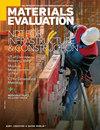Detectability of Small True-T Hole Image Quality Indicators by Digital Radiographic Techniques
IF 0.3
4区 材料科学
Q4 MATERIALS SCIENCE, CHARACTERIZATION & TESTING
引用次数: 0
Abstract
Image quality indicators (IQIs) are used to ensure quality in radiography. The requirements for hole-type IQIs have changed from MIL-STD-453-C (US DOD 1984) to ASTM E1742 and E1025 (ASTM 2018a, 2018b). For materials thinner than 0.50 in., the 2-2T hole does not represent 2% sensitivity. E1025 introduced true-T hole IQIs, where the 2-2T hole represents 2% sensitivity. Stainless steel true-T hole IQIs were fabricated using drills and a plasma-focused ion beam instrument. They were imaged using digital radiography (DR), computed radiography, and X-ray film to determine the limit of their visibility. DR was able to detect holes on the order of 2 to 3 pixels in diameter. All three techniques were able to detect the 2T hole in the number 4 IQI while DR was able to detect it in the number 3 IQI. These hole sizes are near the limit where geometric magnification would be required. The better sensitivity of DR is probably a result of being able to minimize fixed structural noise. Presently, for materials thinner than 0.50 in., there is the option to use IQIs defined by either E1742 Annex A1 or E1025. It is recommended that inspection procedures require a particular sensitivity percent that would necessitate the use of a specific IQI.用数字射线照相技术检测小真t孔图像质量指标
图像质量指标(iqi)用于保证放射照相的质量。孔型iqi的要求已从MIL-STD-453-C (US DOD 1984)更改为ASTM E1742和E1025 (ASTM 2018a, 2018b)。适用于厚度小于0.50英寸的材料。, 2-2T孔不代表2%的灵敏度。E1025引入了真t孔IQIs,其中2-2T孔代表2%的灵敏度。利用钻头和等离子体聚焦离子束仪器制备了不锈钢真t孔IQIs。使用数字放射照相(DR)、计算机放射照相和x射线胶片对其进行成像,以确定其可见性的极限。DR能够探测到直径为2到3个像素的孔。这三种技术均能检测到4号IQI中的2T孔,而DR能检测到3号IQI中的2T孔。这些孔的尺寸接近几何放大的极限。DR较好的灵敏度可能是由于能够将固定结构噪声降至最低。目前,对于厚度小于0.50英寸的材料。,可以选择使用E1742附录A1或E1025定义的iqi。建议检验程序要求特定的灵敏度百分比,这将需要使用特定的IQI。
本文章由计算机程序翻译,如有差异,请以英文原文为准。
求助全文
约1分钟内获得全文
求助全文
来源期刊

Materials Evaluation
工程技术-材料科学:表征与测试
CiteScore
0.90
自引率
16.70%
发文量
35
审稿时长
6-12 weeks
期刊介绍:
Materials Evaluation publishes articles, news and features intended to increase the NDT practitioner’s knowledge of the science and technology involved in the field, bringing informative articles to the NDT public while highlighting the ongoing efforts of ASNT to fulfill its mission. M.E. is a peer-reviewed journal, relying on technicians and researchers to help grow and educate its members by providing relevant, cutting-edge and exclusive content containing technical details and discussions. The only periodical of its kind, M.E. is circulated to members and nonmember paid subscribers. The magazine is truly international in scope, with readers in over 90 nations. The journal’s history and archive reaches back to the earliest formative days of the Society.
 求助内容:
求助内容: 应助结果提醒方式:
应助结果提醒方式:


